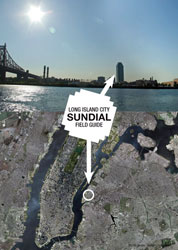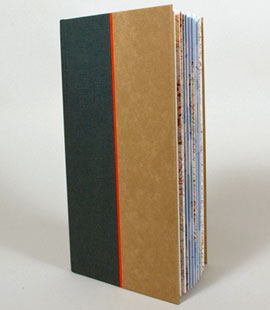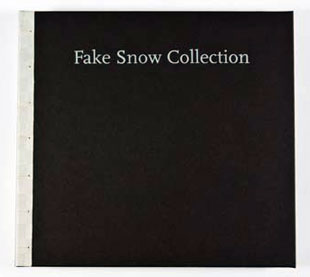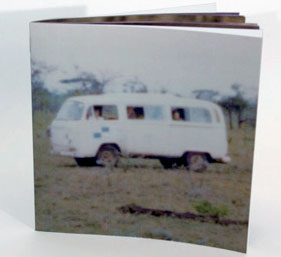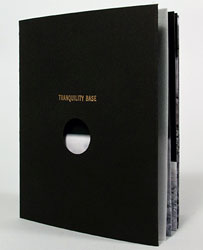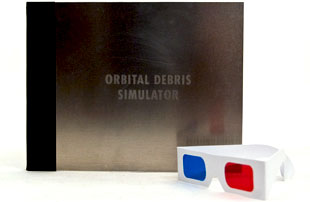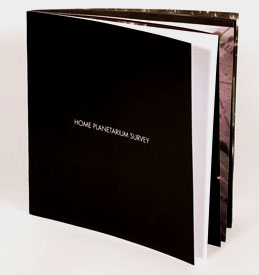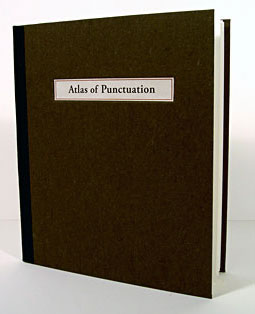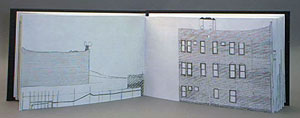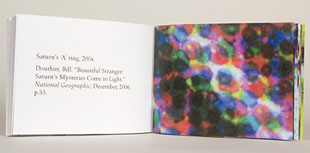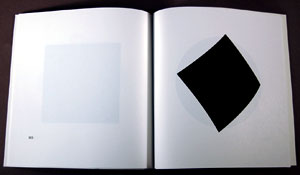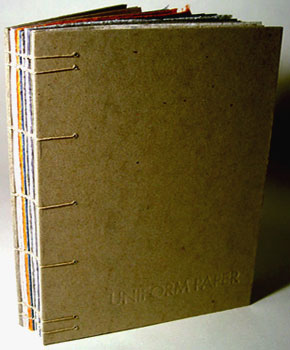
|
Heidi Neilson ~ New York |
Share this page: |
| Heidi Neilson is an artist addressing topics such as weather, fake snow, and the cultural landscape of outer space. Her work is often collaborative and publishing-based. | |
| Long Island City Sundial Field Guide By Heidi Neilson New York: Heidi Neilson, 2013. Edition size not stated. 5.83 x 8.26"; 60 pages. Casebound. Digital offset printed. Softcover illustrated wraps. Heidi Neilson: "The Long Island City Sundial is a neighborhood-wide sundial in Queens, New York, just across the East River from Manhattan. The prominent 201-meter Citicorp building's shadow can be tracked across the neighborhood and used to tell time throughout the day and year. Since this sundial's shadow-casting spire (the gnomon) is vertical instead of at a customary angle, the length of the shadow at any given time changes from day to day. The dial is the irregular terrain of buildings and elevated roads and tracks in a neighborhood that slants down toward the nearby East River. The Long Island City Sundial Field Guide assists reading and experiencing the sundial through maps, landmarks, observation areas, tours and events." $30 |
|
| Atlas Dream Sequence By Heidi Neilson New York: Heidi Neilson, 2011. Edition of 25. 5.75 x 11.125 x 1" 36 pages. Inkjet printed. Drumleaf case binding with the spine and half the boards cloth-covered and the foredges and half the book paper-covered. Heidi Neilson: "Atlas Dream Sequence is a series of collages made from maps, where each page spread is an imagined magnification from the previous spread. The front and back of the book are equal; the sequence of images can be read from either direction." The Book Artist is in Wonderland: depending on which end of the book your start from, the views either zoom in or zoom out. Perspective is all, but never final. $ 450 |
|
Fake Snow Collection 8.5 x 9 x 1"; 75 pages. Printed on a HP Indigo Press. Hand bound. Exposed spine binding. Reprinted texts are used with permission. Fake Snow Collection was produced while Neilson was artist-in-residence at Visual Studies Workshop in November of 2009. The artist-in-residence program at VSW is supported by the National Endowment for the Arts. Fake Snow Collection includes annotated images of 40 fake snow specimens, 17 topical readings accompanied by images of fake snow in use, and 24 samples of fake snow. Does objecting to black garb for The Nutcracker's snowflake dancers make you a racist? Why does snow show up so frequently in paintings from the Northern Renaissance? Inquiring minds … will find consummation in Fake Snow Collection. Artist’s Books Unshelved, Artificial Reality $300 |
|
On Safari, 1976 7.5 x 7.5"; 26 unnumbered pages. Digital-offset printed, saddle-stitch bound. Colophon: "The photographs for On Safari, 1976 were selected from the archives of Lilian Neilson (1913 - 1996). It is a series of reproduced photographs with zoomed-in excerpts." With this simple book, photographer-bookmaker Neilson asks some not-trivial questions about photography: Is its value in recapturing the past? Remembering the past? Reproducing reality, whatever reality is? How much does focus play a part? Is the past fuzzier the farther (literally and figuratively) we are from it? Or does closer vision blur the picture? |
|
| Space projects by Neilson | |
| Tranquility Base By Heidi Neilson New York: Heidi Neilson, 2012. Edition of 50. 5.5 x 7 x .25"; 16 pages. Digital offset printed. Pamphlet stitched by hand. Laid in paper wrapper with title stamped in gilt on front cover. References listed on colophon page. Heidi Neilson: "Tranquility Base is a visual catalog of items left at the Apollo 11 landing site on the moon made with photos of miniature handmade models in diorama settings." Introduction: "Most equipment launched for the Apollo moon missions remains on the moon. Over 100 items occupy the Apollo 11 Tranquility Base landing site. The exact locations and conditions of most of the items were not documented at mission completion and the site has not yet been revisited. This is a constructed visual guide to items at the site." $30 |
|
Orbital Debris Simulator "I wanted to use the metal for the cover for its spaceship-y-ness. You’ll find that it fingerprints easily (aluminum) but the fingerprints also clean off easily with windex on a paper towel. The covers will also probably get scratched (and are a little already in addition to the sandblasted title) but this is fine--planned and appropriate even--as the text references scratches, dings and abrasions from the impact of orbital debris on spacecraft. " |
|
Home Planetarium Survey 7.5 x 7.5"; 16 pages. Digital-offset printed. Saddlestitch bound. Signed and numbered by Neilson. Heidi Neilson: "Home Planetarium Survey displays seven toy planetariums and photograms of the constellation Orion as projected by the planetariums." The seven home planetariums: Orbiter Motorized Planetarium and Talking Film Projector, model #ORPTS $20 |
|
| Out of Print / Sold titles by Heidi Neilson: | |
Atlas of Punctuation 9.75 x 8.5" with 32 pages. Black cloth spine with paper covered boards. Letterpress printed on Mohawk Superfine 80 lb. cover paper using Adobe Garamond and Avenir typefaces for informational text. Typefaces used on the punctuation distribution pages match those of the source books as closely as possible. Created with support from Women's Studio Workshop. Atlas of Punctuation displays the distribution of all end-of-sentence punctuation found in fourteen books. The punctuation for each book is consolidated onto a single sheet, representing in one plane the coordinates of all the verbal boundaries of the book. The books represented in Atlas of Punctuation are literary classics that convey qualities of space and scale. Richard Goodman, Fine Books & Collections (January/February 2008): "Each page is not only weirdly beautiful but also offhandedly informative about the book. Seeing a minimum of question marks among hundreds of periods on the page devoted to One Hundred Years of Solitude tells you something about the certitude the author has for his story. ... "But the first question a viewer has when confronted with these pages is 'How did she do it?' You can trace the punctuation of one page of a book, of course, but 383 pages - as in One Hundred Years of Solitude - is another matter. "'I first went through each book, page by page, with a sheet of clear acetate and a pen, tracing the end-sentence punctuation, registering each page,' Neilson said. 'When the sheets became confusing, I'd use another. When I finished that, I stacked the acetate sheets and scanned them. Using the Adobe Illustrator graphics program, I replaced all of my hand-traced punctuation with typeface punctuation. The result was clean vector graphics, which I sent to a place that makes magnesium plates that are mounted type-high, meaning they can be printed letterpress as if they were a block of set metal type. I printed the book letterpress with the plates." |
|
A Block of Alleys 5.75 x 9.25' with 19 pages. Accordion fold structure with black cloth boards. Etchings, printed letterpress on BFK Rives paper. Richard Goodman, Fine Books & Collections (January/February 2008): "If ever an artist was inspired by her neighborhood, that artist is Heidi Neilson. Neilson lives in Long Island City, a pocket of New York City just across from Manhattan, in Queens. It was once supposed to be the next up-and-coming neighborhood. Instead, after a brief flurry of renown, it settled back into its old identity of small warehouses and undistinguished apartment buildings and diners, all basking in general contentment at being left alone. "... Her neighborhood has inspired her as a book artist…. In 2005 she created A Block of Alleys, a foldout book of etchings she made of all the alleys that she walks near her studio. You can open a single fold and see a single alley, or you can unfold the book completely and see the entire walk, alley after alley, as a panorama." |
|
Stargazing by Microscope |
|
Typography of the Period: 8.5 x 8.5" with 56 pages in white and black wraps. A survey of the design of periods in 26 common typefaces. The periods are presented greatly enlarged for close examination. Richard Goodman, Fine Books & Collections (January/February 2008): "While learning letterpress, [Heidi Neilson] noticed that some of the periods she was setting looked damaged. They weren't perfectly round, as she had expected they would be, but they weren't, in fact, damaged. 'I was impressed that someone had actually designed a period,' Neilson said. She decided to demonstrate this dramatically and so chose over two dozen typefaces and enlarged their periods 3,000 percent…. The result is a book of periods that are as different as children in the same family are. Some are perfectly round, some perfectly square, while others veer into the oblong, the oval, and even, as in the typeface Papyrus, the indescribable."
|
|
Uniform Paper 6 x 8". Entirely of handmade paper. Coptic bound by hand between raw boards. Title blind-stamped on the front cover. Colophon blind-stamped on inside of back cover. Signed and numbered. The pages are ordered roughly in sequence of the wearing of each uniform in a lifetime (where uniform is loosely defined) — so that the pages in order are: diaper paper, underpants paper, ballet costume paper, brownie uniform paper, etc. and later… wedding dress, tuxedo, prison jumpsuit, surgical scrubs, etc….. Colophon states: “The paper for each page in this book is handmade from a uniform acquired through ebay, except for the Underpants, Jeans, and T-shirt papers, which came directly from our own wardrobes. Uniform Paper is letterpress printed using the typeface Futura.” Each sheet of paper has brief letterpress text describing its “fiber.” |
|
Page last update: 02.15.2023
Home | About Us | Contact Us | New Arrivals | Fine Press & Artists' Books | Broadsides |Resource Books | Order/Inquiry
Copyright © 2021 Vamp & Tramp, Booksellers, LLC. All rights reserved.
